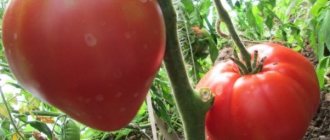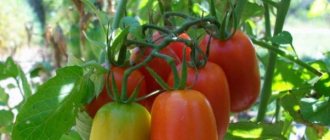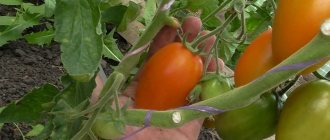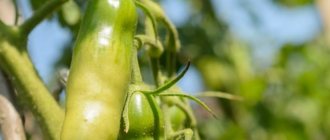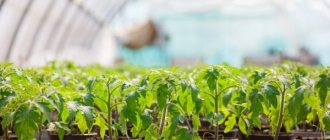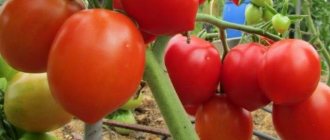A wide variety of tomato varieties allows you to choose the one you want. The shapes of the fruits of this plant are sometimes surprising. They can resemble plum, cherry, peach, currant, pear, lemon, egg. The varieties also differ in color: from the usual red to yellow, purple, orange. And the range of sizes is amazing: from a few grams to 2 kg (Giant). The Agata tomato has a color, weight and shape that is familiar to the eye of a gardener and just a consumer. Yes, and growing it on your own plot will not be difficult. Since agricultural techniques are not too complicated, even a novice vegetable grower can get a good harvest of this vegetable, which contains 2-3% sugar, organic acids and a whole range of vitamins, without much expense.
Characteristics and description of the variety
Early variety. Fruiting occurs on average three months after the appearance of the first shoots. Agata bushes are determinate (that is, having limited growth). The fruits are red, slightly flattened, round. Weight up to 110 grams. The taste is sweet with a slight sourness. With proper agricultural cultivation techniques, you can get up to 4 kg from one bush, which is similar to the Auria variety. From 3 to 6 tomatoes are tied on a brush. This variety can be grown both in open ground and in greenhouses. Universal application, average transportability.
With proper agricultural cultivation techniques, you can get up to 4 kg of Agata variety tomatoes from one bush
Pest and disease control
To protect the Agata tomato from late blight, it is necessary to treat the bushes with garlic and onion tincture. To prepare it, leave 100 g of onion and 100 g of garlic in a bucket of water for 24 hours. It can be used to treat every infected tomato.
Another effective method against late blight is treatment with curdled milk (100 g per 1 liter of water with the addition of 3 drops of iodine).
To combat insect pests, you should use the following means:
- for whitefly - “Confidor”;
- for slugs - a mixture of ash, tobacco dust and lime;
- for spider mites - “Karbofos”.
Features of the variety
Agatha is not much different from other early varieties, but there are still some features:
- low-growing bushes . The tallest can reach half a meter.
- early ripening will slightly protect the bushes from late blight. But this is only possible if the lower leaves do not come into contact with the ground and the gardener carries out all preventive measures on time;
- the fruits are the same in size and weight. In its entirety, this creates an attractive picture for buyers.
Tomato bushes are stunted with fruits of the same size and weight
Country of origin, growing regions
This plant has a strange fate. Homeland: Ecuador and Peru . There it was not considered edible and was called “tomatl”. The French gave it another name - “love apple”, because the fruits of this vegetable reminded them of a heart. Or in French "pomodoro". In the 80s of the 20th century, the famous Russian gardener R.I. Schroeder, describing the tomato, gave it the name Cupid Apple. And in Russia and near abroad the name both tomato and tomato has taken root. Over the past hundred years, many worthy varieties have been developed. One of them is Agatha. Its appearance since 1987 is the result of the work of Russian breeders.
Ecuador - the birthplace of the Agata tomato
Recommended for cultivation in the temperate and southern zone of the country: the Middle Volga region, the North Caucasus, the East Siberian and West Siberian regions.
Advantages and disadvantages
Agatha has both its advantages and disadvantages:
- early variety. This helps to avoid massive damage to bushes by late blight. But only with timely prevention;
- determinate bushes. That is, they do not require pinching, pinching or tying to a support. It depends only on the desire of the gardener to lift them onto a trellis or let them grow without tying them up. True, in order to protect against infection by fungal diseases and achieve even illumination of the leaves and fruit, it would be better to raise it to a standard;
- You can grow a good harvest both from seed and by seedlings. Fruits well in open ground and in greenhouses.
The Agata variety has determinate bushes
Among the biggest disadvantages is susceptibility to fungal diseases , although breeders describe this variety as moderately resistant.
Features of tomato care
The Agata variety is easy to care for. Tomatoes will not cause much trouble for a vegetable grower. Regular watering is a mandatory procedure. It is not advisable to use cold water from a well. The tomato's growth will be stunted. It is better to water with warm water, but for this you will need to place a storage tank on the site.
Tomatoes are fertilized three times throughout the entire season. You can use factory-made complex fertilizers. However, the Agata variety is well susceptible to organic matter. Tomatoes respond well to humus from leaves and mullein, wood ash, and egg shells. You can add a weak solution of chicken manure to the bushes.
Tomato bushes do without the obligatory stepson. The foliage of the lower tier is removed to free up sun access to the fruits. If the vegetable grower believes that too many shoots have grown, then some of them can be removed. The soil under the tomatoes is kept slightly moist. It is optimal to cover the ground with mulch. Overmoistening is unacceptable for the Agata tomato. There is a threat of fungus. Plants love periodic loosening of the soil. Weeds can clog low-growing bushes, so they need to be removed promptly.
Late blight poses a great danger to the Agata tomato. It is better not to wait for an outbreak of an epidemic, but to carry out preventive spraying of plantings with a solution of Bordeaux mixture in advance.
Growing
In order to get a good harvest of tomatoes, the soil must be well prepared and the area must be allocated after certain predecessors.
Preparing the beds
Digging of the site is carried out in the fall after adding humus, compost, leaf soil, etc. They shovel the earth to the size of a bayonet and a half, without breaking the blocks. In the spring, the top layer is loosened with a cat hoe. The blocks are broken and the area is leveled. Clay and loamy soils are not cultivated with particular care, without crushing the soil too much. Since after heavy rains a dense crust may form, which will prevent seedlings.
Different types of soils
Tomatoes cannot be planted after nightshades, that is, plants of the same family. The best predecessors would be: cucumbers, onions, legumes. Acceptable: cabbage, corn.
Condensed plantings have a positive effect on the harvest. They improve the microclimate and increase air humidity. Onions, beans, and asparagus have a good effect on Agata tomatoes.
Seed preparation
There is a very good folk saying that says that a bad seed cannot produce a good tribe. That's why:
- It is better not to buy seed material from random people.
- Strive to grow zoned varieties.
Before sowing seeds, you should estimate how many you will need. To propagate tomatoes, 2–3 grams per ten square meters is enough. Before planting, they are calibrated, disinfected, coated (enriched with nutrients), and soaked. It is possible through bubbling. Pre-sowing stimulants are used (0.1% nicotinic acid solution is the best for tomatoes) and germinated.
Agata tomato seeds
Germinated seeds are planted in moist soil.
Growing seedlings
Tomato seeds are not afraid of cold weather. Therefore, as soon as the soil warms up a little, you can sow them in open ground.
Seedlings are grown in greenhouses, greenhouses, and even on window sills, if the area of future planting is not too large. In order for the seedlings to be ready for planting in open ground by the beginning of May, the seeds are planted in early March. But to obtain an early harvest of Agata tomatoes, they are planted in greenhouses, counting approximately 3 months before transplanting to a permanent place.
Tomato seedlings
In the open ground
Seedlings are planted when the threat of spring frosts has passed. But due to the fact that they can be observed even in May, you need to have a plastic film just in case to protect the plantings from freezing. Early varieties, which include Agata, are planted in the second or third ten days of April. Before planting, the holes are watered. If these are grooves, then they are filled with water. The distance between plants should be about 30 cm, and row spacing should be 50 cm. Gardeners often adhere to the lunar calendar when planting tomatoes.
When planting a tomato, the distance between plants should be about 30 cm, and the row spacing should be 50 cm.
The seedlings are planted in the holes 3–4 cm deeper than they grew in the greenhouses. If the plant has not hardened and is too elongated, then it is placed in the hole with the root and part of the stem at an angle. After planting, the seedlings are watered again and the soil around them is mulched with humus. At first, seedlings need to be watered at least once every three days. Further care consists of:
- loosening the soil;
- weeding;
- feeding;
- glaze;
- pest and disease control.
The first feeding should be two weeks after planting. The second is when fruiting begins. The third - two weeks after the second. The rate of use of mineral fertilizers for the first feeding per 10 liters of water:
- 20 grams of ammonium nitrate;
- 70 grams of superphosphate;
- 50 grams of potassium salt.
For the second and third feedings, nitrogen fertilizers (ammonium nitrate) are not used.
Vegetable growers often forget that tomatoes come from South America and are not from humid areas. Therefore, they normally perceive periods without abundant irrigation. It is better to water Agata variety tomatoes along the grooves at intervals of 10 days. Water consumption - 500 liters per 10 square meters of soil. You can read about how often you need to water tomatoes here.
To enhance and accelerate the formation of fruits, plants are planted. That is, they pinch off the shoots that form in the axils of the leaves.
To obtain an early harvest, seedlings can be planted in ditches. To do this, they are dug up to 40 cm deep, manure is poured in, then turf soil is added, and the plants are planted at an angle.
To enhance and accelerate the formation of fruits, plants are planted
In greenhouses
The soil for planting is dug deeply, after adding rotted humus. Seedlings must be watered before planting. And they make fairly wide holes to avoid damage to the root system. Planted together with a lump of earth so that it does not exceed the level of the soil surface. For more information about how to grow tomatoes in a greenhouse, read this article.
If the seedlings were grown in peat pots, then there is no need to remove them from there.
During the rooting period of the plant, the soil should be moist.
Features of caring for agate varieties in a greenhouse:
- garter. The plant is not tall, it grows up to half a meter, but it is still better to tie it up;
- stepsoning . Shoots form in the axils of the leaves. While they are small, you can break them out in the morning. It is at this time that plants are turgid (contain a lot of moisture). If the shoots are already large, then it is better to cut them diagonally with a sharp knife.
There is no need to pinch the tops of plants of this variety.
Plantings in greenhouses are fed with liquid fertilizers and carried out along with watering. The fruits are collected as they ripen.
Harvesting occurs as the tomato ripens
Landing
Before sowing, seeds are immersed in a solution of potassium permanganate, then washed with clean water and soaked for a day. Plant them at a depth of 5 mm. Shoots can be expected in 5-6 days. The optimal temperature for seed germination is 18-25 degrees.
After the formation of 1-2 true leaves, the seedlings are planted. In the future, caring for seedlings consists of watering, loosening and hardening. It is necessary to pick up the seedlings after they take root. They should be fed once with superphosphate to strengthen the root system.
To harden, containers or pots are taken outside for 2-3 hours, gradually increasing the time. Hardened seedlings take root faster, look strong, stocky, and suffer less from differences in day and night temperatures.
Seedlings are planted in the ground when the threat of frost has passed. The seedlings should have one flowering cluster. The age of the plants by this time is about 60 days.
The bushes are planted at a distance of 30-35 cm from each other. When planting, add a glass of humus to the hole. Afterwards, the plants are watered abundantly, and during cultivation they are fed 2-3 times with complete fertilizer, including nitrogen, phosphorus and potassium.
During the season, plants need to be watered several times, infrequently, but abundantly. Frequent watering worsens the taste of the fruit and reduces the sugar content. Many varieties of tomatoes crack with rare heavy watering, but Agata is resistant to this phenomenon.
What can cause damage to the crop?
Healthy plants are less affected by diseases and insects. But crop losses are still high. Therefore, it is necessary to carry out preventive measures, and if you see damage on the bushes, you should establish their cause and take appropriate measures as early as possible. The Agata variety suffers most from such diseases and pests.
Diseases
- Late blight . The most common disease of tomatoes. Gradually the leaves turn black, and then the fruits. The disease is caused by a fungus. This may be a consequence of changes in humidity and air temperature. And also dense plantings.
The Agata variety is moderately susceptible to this fungal disease. Therefore, both preventive measures and the use of chemicals to combat late blight are needed. Ignoring the signs can lead to complete loss of the crop.
- Viral diseases (leaf mosaic). Characteristic signs: spotting, leaf curling. It infects aphids and nematodes, and the disease also appears after planting infected seeds. The affected plant must be removed immediately.
- Bacterial wilt (bacteriosis). The bush literally begins to wither in a short period. Sick plants are removed.
- Root rot. Caused by fungi. Main signs: death of roots and basal stem. If a vegetable grower sees this, then the affected plants can be watered with a solution of zineb. Tomatoes that are very affected by the disease are removed from the garden and burned.
Manifestation of tomato root rot
Pests
- Scoops . The larvae of moths eat up the roots of plants and they die. Before planting seedlings, the soil is treated with diazinon.
- Medvedka. Propagates well in moist soils. It damages not only the seedlings, but also the tomatoes lying on the ground. To combat this, you can spread small piles of humus and compost around the garden closer to winter. During frosty periods, rake them out. These insects are waiting for warmth there. They can be easily destroyed.
Positive and negative sides of Agatha
Agata has a number of advantages, thanks to which farmers very often prefer this particular potato. Among the advantages of Agatha it is worth noting:
- The variety bears fruit well both on heavy soils and on light, sandy loam soils.
- This is a high-yielding variety.
- Good commercial quality of root crops.
- Immunity to mechanical damage.
- The versatility of tubers.
- Good immunity.
There are no shortcomings as such. The only negative thing we can note is the weak resistance to late blight. Although no variety is completely protected from this disease.
conclusions
Variety Agata is an early variety of tomatoes. It was bred by Russian breeders at the end of the 20th century and still enjoys well-deserved popularity among vegetable growers for its beautiful, smooth fruits with a pleasant sweet taste. Also good transportability, unpretentiousness. The yield is not particularly different from other early varieties and ranges from two to four kilograms per bush. The plant can be planted both in open ground and in greenhouses. Care consists of loosening, weed removal, watering, fertilizing, pest and disease control. Also read about the interesting tomato variety Klusha.
Advantages and disadvantages
Among the main advantages of the variety :
- excellent potato taste;
- good yield;
- possibility of long-term storage and transportation;
- versatility of use;
- undemanding to soil composition;
- drought resistance;
- tolerance to the vagaries of the weather;
- resistance to major diseases.
The variety has practically no disadvantages . To obtain maximum yield, dosed watering, abundant fertilizing and frequent loosening of the soil are recommended.
And in the table below you will see what the yield indicators are for other varieties:
| Variety name | Productivity (c/ha) |
| Aladdin | 450-500 |
| Beauty | 400-450 |
| Grenada | 600 |
| Vector | 670 |
| Sifra | 180-400 |
| League | 210-350 |
| Elmundo | 250-345 |
| Cast iron | 100-200 |
| Sheri | 170-370 |
| Bryansk delicacy | 160-300 |
Farmer reviews
This section presents the opinions of those who grew the variety on their plots. Reviews from summer residents are mostly positive .
Sergey, Kuban : “I’ve been planting Agata per hectare for 2 years now. I add humus to the fields in the fall. My harvest is rich. I harvest at the end of July and leave several rows for seeds. The taste of potatoes is unique, sweetish. There is little starch in the fruit, so you can cook any dish, the potatoes do not disintegrate. The puree is especially delicious: you’ll lick your fingers!”
Margarita, Moscow : “First of all, I would like to note the simple care of seedlings. In addition, my plants practically do not get sick, although I have been growing the crop for more than one year. I fight the Colorado potato beetle well in advance of its appearance. I spray the seedlings with insecticides and potassium permanganate. I also plant mustard and marigolds between the bushes. Potatoes are very tasty and suitable for any dish. Particularly good in baking and as a pie filling.”
Plant characteristics
This is a table variety, early ripening , fruit ripening occurs 80-85 days from the moment of sowing. But the first excavation is carried out after 50-55 days.
The bushes are low, spreading, and the foliage is medium . The leaves are small, dark green, the flowers are large, white. The root system is powerful and well developed, so the fruits grow quickly. There are practically no small potatoes.
The crop's disease resistance is above average ; the plant is immune to Alternaria, verticillium and potato blight, but is affected by late blight and fusarium.
Productivity
The variety is distinguished by high fruiting rates ; up to 400 centners are harvested from 1 hectare. One seedling produces 10-15 potatoes. The tubers retain their marketable appearance until spring and have a high shelf life. For stable and rich fruiting, plants must be planted in fertile, well-fertilized soil, although seedlings can grow in heavy clay soil.
Other potato varieties:
Adretta potatoes from German breeders
Mid-early potato Charodey from domestic breeders
Potatoes "Crimean Rose" for growing in hot climates
How to harvest and store crops
Agata potatoes can be harvested 60 days after planting. Store the harvest in a cool, dark place. The ripening process of the crop takes about 30 days.
Storage features and shelf life of the Agata variety
The preservation of presentation during storage is affected by air temperature, humidity, ventilation, and the amount of daylight.
To prevent fruits from germinating, they must be stored at a temperature of 3 ⁰C. The storage room should have minimal sunlight. Air humidity is 80%.
How to properly care for the variety
To get an early and abundant harvest, you should know some nuances in the care and maintenance of Agata potatoes.
Features of watering
The variety is drought-resistant, so 3 abundant waterings per growing season will be sufficient:
- a few days after planting;
- during the period of bud formation;
- during flowering.
Note! In very dry weather, it is recommended to moisten the soil, as too long a drought will negatively affect the quantity and quality of the harvest.
Feeding and fertilizing
Agata prefers frequent feeding. During the growing season, fertilizers are applied at least 3 times. The fertilizer should contain macroelements such as potassium and magnesium, which contribute to the rapid growth and development of fruits.

